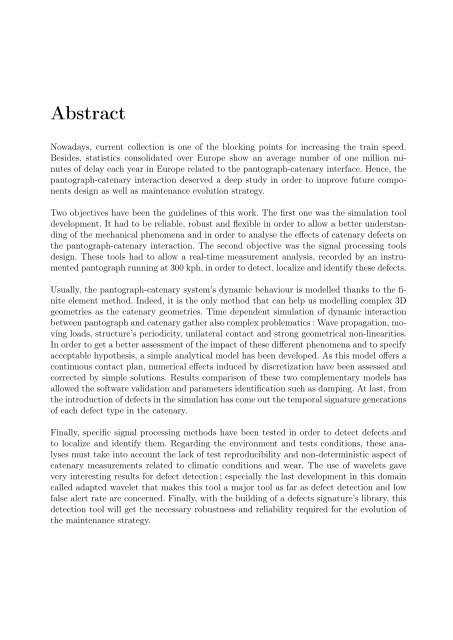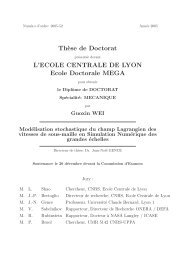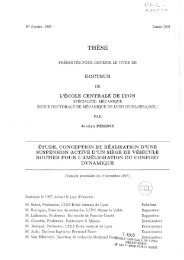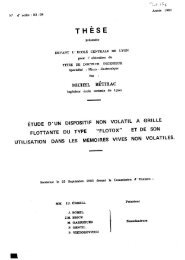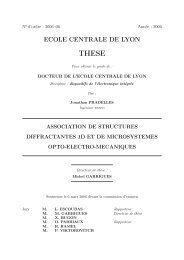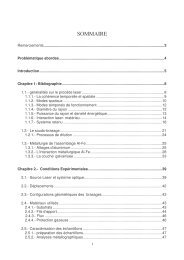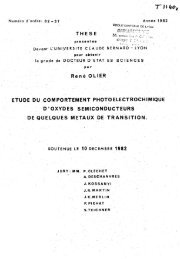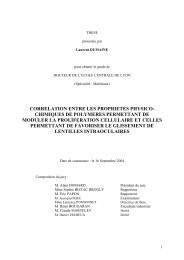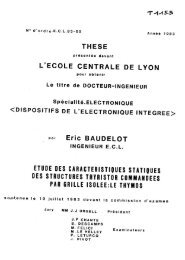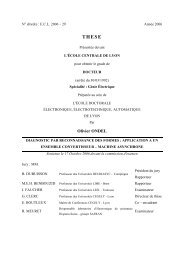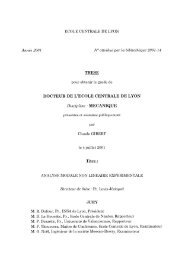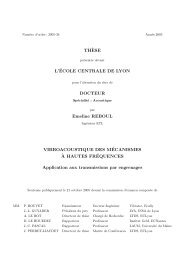Mécanique Modélisation du comportement dynamique du couple ...
Mécanique Modélisation du comportement dynamique du couple ...
Mécanique Modélisation du comportement dynamique du couple ...
Create successful ePaper yourself
Turn your PDF publications into a flip-book with our unique Google optimized e-Paper software.
AbstractNowadays, current collection is one of the blocking points for increasing the train speed.Besides, statistics consolidated over Europe show an average number of one million minutesof delay each year in Europe related to the pantograph-catenary interface. Hence, thepantograph-catenary interaction deserved a deep study in order to improve future componentsdesign as well as maintenance evolution strategy.Two objectives have been the guidelines of this work. The first one was the simulation tooldevelopment. It had to be reliable, robust and flexible in order to allow a better understandingof the mechanical phenomena and in order to analyse the effects of catenary defects onthe pantograph-catenary interaction. The second objective was the signal processing toolsdesign. These tools had to allow a real-time measurement analysis, recorded by an instrumentedpantograph running at 300 kph, in order to detect, localize and identify these defects.Usually, the pantograph-catenary system’s dynamic behaviour is modelled thanks to the finiteelement method. Indeed, it is the only method that can help us modelling complex 3Dgeometries as the catenary geometries. Time dependent simulation of dynamic interactionbetween pantograph and catenary gather also complex problematics : Wave propagation, movingloads, structure’s periodicity, unilateral contact and strong geometrical non-linearities.In order to get a better assessment of the impact of these different phenomena and to specifyacceptable hypothesis, a simple analytical model has been developed. As this model offers acontinuous contact plan, numerical effects in<strong>du</strong>ced by discretization have been assessed andcorrected by simple solutions. Results comparison of these two complementary models hasallowed the software validation and parameters identification such as damping. At last, fromthe intro<strong>du</strong>ction of defects in the simulation has come out the temporal signature generationsof each defect type in the catenary.Finally, specific signal processing methods have been tested in order to detect defects andto localize and identify them. Regarding the environment and tests conditions, these analysesmust take into account the lack of test repro<strong>du</strong>cibility and non-deterministic aspect ofcatenary measurements related to climatic conditions and wear. The use of wavelets gavevery interesting results for defect detection ; especially the last development in this domaincalled adapted wavelet that makes this tool a major tool as far as defect detection and lowfalse alert rate are concerned. Finally, with the building of a defects signature’s library, thisdetection tool will get the necessary robustness and reliability required for the evolution ofthe maintenance strategy.


